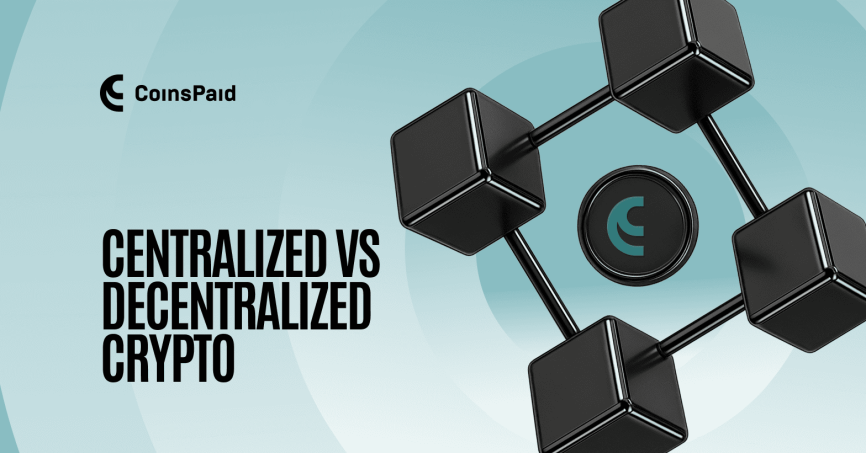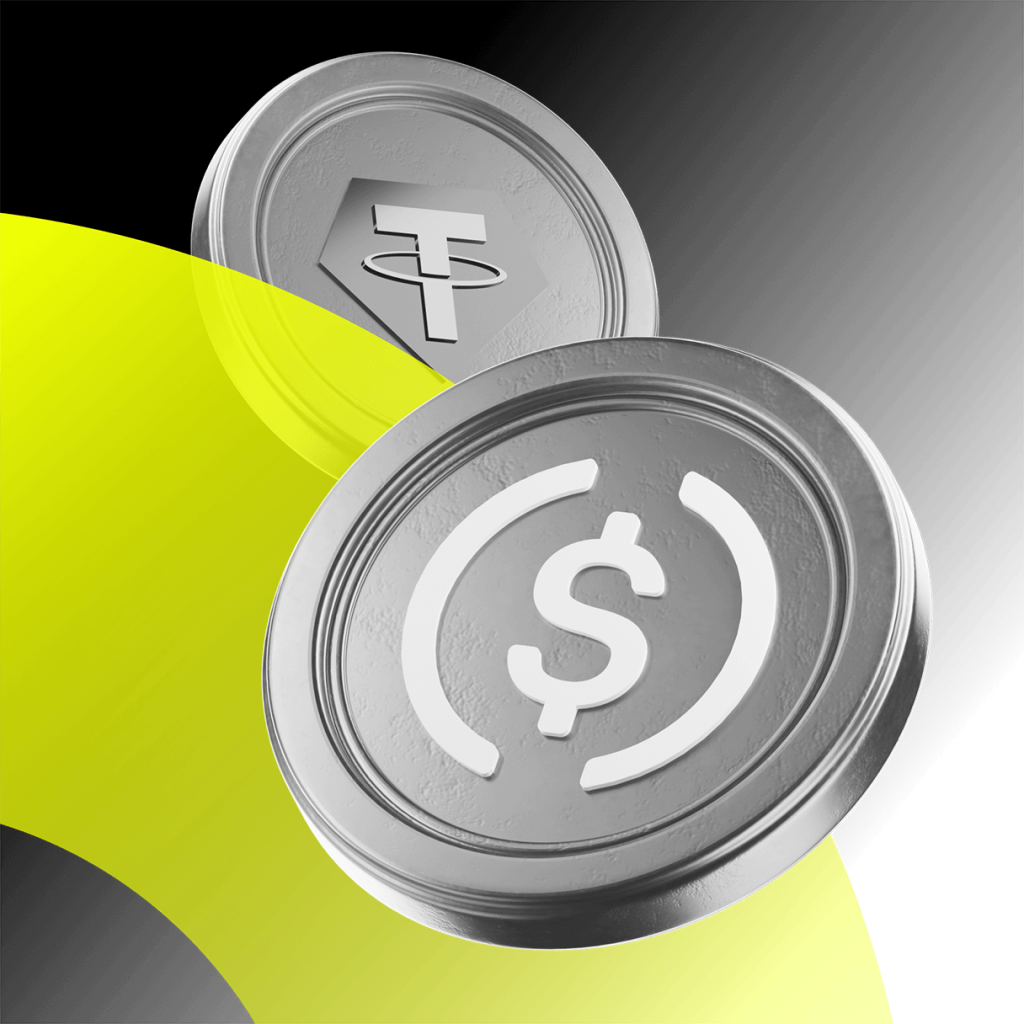Centralized vs decentralized crypto (CEX vs DEX)

Table of contents:
In crypto, one of the most important distinctions – especially for businesses – is between centralized and decentralized systems.
This is particularly relevant when it comes to stablecoins: blockchain-based tokens designed to maintain a steady value.
By 2024, stablecoins accounted for about 80% of crypto transactions in business. CoinsPaid’s data shows that in 2023, stablecoins represented 73% of total transaction volume, while Bitcoin accounted for just 19%.
What’s more impressive is that stablecoins were responsible for moving about $27.6 trillion in 2024, surpassing Visa and Mastercard’s combined volume by roughly 7.7%.
Stablecoins combine fiat-like stability with the speed and 24/7 nature of crypto payments, making them essential for businesses adopting digital assets.
As such, more and more companies use stablecoins for international payments, payroll, remittances, and liquidity management.
They also function as a secure entry point into crypto – bridging traditional finance with blockchain efficiency.
Today’s analysis will break down the two main types of stablecoins – centralized and decentralized – to help you understand which model best suits your business.
We’ll explore how they work, where they differ, and what trade-offs each one brings in terms of trust, compliance, control, and risk.
What are stablecoins?
Stablecoins are digital assets pegged to stable reserve assets like fiat currency, gold, or baskets of assets.
Pegs are maintained either through reserves (centralized) or smart contracts and crypto collateral (decentralized). This makes them ideal for payments, savings, and lending – use cases that volatile cryptocurrencies struggle to support.
Stablecoins enable real-time, low-cost international payments without intermediaries or banking hours. For example, paying overseas suppliers with a USD-backed stablecoin can cost just pennies and settle in minutes, 24/7. They also offer a digital dollar alternative in regions with weak currencies or limited banking access.
Their popularity is especially prominent in Central, Northern, and Western Europe, which received $987 billion in on-chain crypto value between July 2023 and June 2024 – about 22% of global transaction volume – making it the world’s second-largest crypto economy after North America.
Centralized vs decentralized stablecoins
Stablecoins fall into two main categories:
Centralized stablecoins
Issued by a company and backed by off-chain reserves (e.g., cash in banks). Examples include USDC and USDT. Their peg is maintained by trust in the issuer and often audited. These are regulated and function much like digital IOUs.
Decentralized stablecoins
Operate without a central authority. Pegs are managed via algorithms or overcollateralized smart contracts. Examples include DAI, LUSD, and Frax. They offer greater transparency and censorship resistance but involve more technical risk.
Understanding the difference between centralized and decentralized crypto stablecoins is essential, as each type offers different trade-offs in control, transparency, and trust.
Cex vs Dex: Centralized stablecoins
Centralized stablecoins are issued by companies that hold fiat reserves and manage the token supply.
Each token (e.g. 1 USDC) is backed 1:1 by assets like USD and can be redeemed through the issuer. Leading examples include USDT (Tether, ~$155B market cap) and USDC (Circle, ~$62B). Others include BUSD, USDP, and PYUSD.
Stablecoins are minted when fiat is deposited and burned when redeemed. Issuers provide attestations or audits to maintain trust. Some, like GUSD and PYUSD, operate under financial regulation.
Centralized stablecoins: Advantages
Centralised stablecoins come with a number of advantages for businesses.
- Regulatory compliance. Centralized stablecoins often comply with KYC/AML laws, offer blacklist functions, and operate under oversight. This makes them suitable for businesses needing legal clarity and risk management.
- Stable value. Fiat reserves ensure price stability, making tokens like USDT and USDC reliable for payments and treasury. With no algorithmic mechanisms, the peg is straightforward and predictable.
- High liquidity & usage. These coins are widely accepted across exchanges and payment platforms, including CoinsPaid. Their ubiquity ensures smooth conversions and low transaction friction.
- Banking integration. Some, like USDC, integrate with traditional finance for easier swaps between crypto and fiat. Players like Standard Chartered and PayPal are testing stablecoins for global transfers, signaling mainstream adoption.
Centralized stablecoins: Disadvantages
There are some risks to be aware of when it comes to centralized stablecoins, such as:
- Issuer risk. Users must trust the issuer and custodial banks. Reserve mismanagement, as seen in past Tether controversies, could lead to depegging or collapse.
- Censorship & control. Issuers can freeze or block addresses. While helpful for fraud mitigation, this undermines crypto’s decentralization ethos and raises concerns for sensitive-use cases.
- User friction (KYC). Interacting with these coins often requires identity verification. This excludes users without access to formal documentation and limits open access.
- Regulatory uncertainty. Regulatory actions can halt a stablecoin’s issuance or redemption. The 2023 Paxos-BUSD case showed how quickly compliance issues can disrupt usage. While upcoming regulations may legitimize compliant coins, the landscape remains fluid.
Ultimately, centralized stablecoins offer trust, compliance, and seamless integration – but at the cost of decentralization, user control, and exposure to issuer and regulatory risks.
Decentralized stablecoins
Decentralized stablecoins maintain price stability without relying on a central issuer. Instead, they use smart contracts, on-chain collateral, and community governance to manage supply and keep a peg to fiat values (like $1). They are transparent, non-custodial, and accessible to anyone with a crypto wallet.
There are two subcategories of decentralized stablecoin:
- Crypto-collateralized. Backed by other crypto assets. Users lock volatile tokens (e.g., ETH) into smart contracts to mint a smaller amount of stablecoins, typically over-collateralized (e.g., $150 in ETH to mint $100 in DAI). Collateral is automatically liquidated if prices fall too far.
- Algorithmic. Use programmed supply adjustments and secondary tokens to maintain the peg without direct collateral. These are high-risk; TerraUSD’s 2022 collapse showed how fragile algorithmic designs can be if market confidence breaks.
Many modern stablecoins (DAI, Frax, LUSD) blend both models, relying on crypto collateral and algorithmic governance to remain stable – without touching fiat.
Decentralized stablecoins: Advantages
Just like centralized stablecoins, decentralized stablecoins have their advantages and disadvantages. Starting with the benefits, they come with:
- Censorship resistance. No central authority can freeze funds or block transactions. This is crucial in high-risk jurisdictions or use cases requiring financial autonomy.
- On-chain transparency. All collateral and system activity are public. Users can verify reserves in real time – no need to rely on audits or third-party attestations.
- Open access (no KYC). Anyone can use decentralized stablecoins globally without identity checks. This supports inclusion, especially in underbanked regions.
- Smart contract integration. These coins are deeply integrated into DeFi – ideal for automated payments, lending, or programmable business processes like payroll or escrow.
- No bank dependence. With no fiat reserves or intermediaries, there’s no risk of assets being frozen or lost to a bank failure, as happened briefly with USDC in 2023.
Decentralized stablecoins: Disadvantages
The disadvantages of decentralized stablecoins should also be considered:
- Complex collateral systems. Peg stability relies on volatile crypto assets and complex liquidation mechanisms. Under stress, collateral value may fall too fast to maintain the peg.
- Limited scale & liquidity. Supply depends on available crypto collateral. This limits minting capacity and can lead to low liquidity, making it less ideal for high-volume business use.
- Legal uncertainty. Without a clear issuer or regulatory framework, these stablecoins may face legal ambiguity, especially in jurisdictions wary of algorithmic tokens. In the EU, for instance, MiCA effectively prohibits stablecoins that lack full asset backing.
- Smart contract risk. Bugs or exploits in code can compromise stability or drain reserves. Even audited protocols carry non-zero technical risk.
- No emergency controls. Unlike centralized issuers, there’s no quick intervention during a crisis. Governance processes may be too slow, and some events could spiral out of control.
Overall, decentralized stablecoins offer transparency, accessibility, and control – but introduce complexity, volatility risk, and regulatory grey zones.
Centralized vs decentralized stablecoins (cex vs dex crypto)
Both centralized and decentralized stablecoins aim to provide a stable digital dollar, but they do so with fundamentally different models. Here’s a side-by-side breakdown:
| Aspect | Centralized Stablecoins (CEX-like) | Decentralized Stablecoins (DEX-like) |
|---|---|---|
| Control & Governance | Managed by a company or consortium. Centralized decisions and oversight. | Run by smart contracts and governed by community votes (if any). No single point of control. |
| Reserve Backing | Backed 1:1 by fiat reserves held off-chain (e.g. USD in bank accounts). | Backed by crypto collateral (often over-collateralized) or algorithmic supply models. |
| Trust Model | Trust in the issuer, its reserves, and audit reports. | Trust in code, collateral, and protocol design – no need to trust a company. |
| Regulatory Compliance | KYC/AML enforced at on/off ramps; funds can be frozen. Regulated or licensed. | No built-in KYC. Harder to regulate; governments may restrict access via broader DeFi limitations. |
| Transparency | Periodic attestations; reserves not visible in real time. | Fully transparent; collateral and protocol actions are viewable on-chain 24/7. |
| Censorship & Control | Issuer can freeze or blacklist funds. | No freeze function. Assets are censorship-resistant and self-custodied. |
| Risk Profile | Risk of regulatory action, issuer default, or reserve opacity. | Risk of smart contract bugs, collateral crashes, or protocol failures (e.g., algorithmic depegs). |
| Liquidity & Adoption | Highly liquid, broadly accepted. Easier fiat conversions. | More limited liquidity. Top options (e.g., DAI) widely used in DeFi but fewer fiat off-ramps. |
| Speed & Cost | Fast and cheap, depending on chain (e.g., Tron, Solana, Ethereum). | Also chain-dependent. Both benefit from crypto’s always-on, near-instant settlement. |
| Examples | USDT, USDC, BUSD, PYUSD, USDP. | DAI, FRAX, LUSD, (former) UST. |
The core trade-off is trust vs autonomy: centralized stablecoins offer regulatory clarity and integration with financial systems, but require trust in an intermediary. Decentralized stablecoins grant full control and transparency, but introduce technical and market risks.
When to choose centralized stablecoins
Susanna Bondarenko, Researcher at CoinsPaid writes:
“For most businesses, centralized stablecoins like USDC or USDT are the practical choice due to their familiarity, regulatory alignment, and liquidity…”
They are great when:
- You operate in a regulated environment. These coins comply with KYC/AML standards and are often issued under clear legal frameworks, making them suitable for public companies, finance, and enterprises requiring auditability.
- You need high liquidity and fiat access. Centralized stablecoins are widely supported on exchanges and payment platforms, offering easy conversion to fiat and minimal slippage – ideal for paying suppliers or payroll.
- You prefer trusted issuers and institutional oversight. Knowing a reputable company holds reserves in audited banks can align with internal risk policies and stakeholder expectations.
- You want seamless banking integration. Major stablecoins plug into existing payment systems and APIs, enabling cross-platform transfers, fiat on/off ramps, and smoother customer experiences.
- You require compliance features like transaction monitoring. Centralized coins support fraud tools, blacklisting, and even chargeback-like interventions – valuable for businesses handling high transaction volumes.
Take an example – a global e-commerce firm using USDC can instantly repatriate daily revenue from international sales to their U.S. HQ. Blockchain speed improves cash flow, while USDC’s auditability satisfies accountants and regulators.
When to choose decentralized stablecoins
Susanna Bondarenko:
“Decentralized stablecoins like DAI, on the other hand, are ideal for businesses valuing autonomy, transparency, or deep DeFi integration.”
They are usually a best fit if:
- You need censorship-resistance and full custody. With no central authority, funds can’t be frozen. Essential for DAOs, businesses in restricted regions, or those serving sensitive markets.
- You’re targeting underbanked regions. In areas with unstable fiat or limited banking, decentralized stablecoins provide open access to digital dollars without KYC friction.
- You’re DeFi-native. Web3 apps, games, or DeFi platforms benefit from composability – DAI can be used across lending pools, escrow contracts, or yield-generating strategies.
- You want to diversify from centralized issuers. Using DAI or similar as a hedge can mitigate reliance on any single provider, especially during outages or legal clampdowns.
- Your brand aligns with decentralization. Paying users or freelancers in DAI can signal alignment with crypto values and appeal to privacy-conscious, crypto-savvy audiences.
Use centralized stablecoins for compliance, ease of use, and cash-flow efficiency. Opt for decentralized stablecoins when control, transparency, or DeFi integration are top priorities. Many businesses benefit from using both – balancing safety and flexibility.
As a cautionary note, make sure to avoid unproven algorithmic stablecoins. The collapse of TerraUSD (UST) is a reminder that poorly designed systems can wipe out billions. Stick to over-collateralized or time-tested options like DAI.
Align your strategy with a stablecoin model or risk being left behind
Whether centralized or decentralized, stablecoins allow companies to move value globally, quickly, and at low cost (all while avoiding crypto’s usual volatility).
Centralized stablecoins like USDC and USDT offer strong liquidity and seamless fiat integration, which makes them appealing for merchants, fintechs, and enterprises. And while some — such as USDT — have faced regulatory hurdles in certain regions like the EU, these stablecoins continue to see widespread use globally.
In contrast, decentralized options like DAI provide greater autonomy and on-chain transparency, making them ideal for crypto-native projects or operations in emerging markets where censorship or limited banking access is a concern.
The right choice depends on your business model, customer base, and risk profile. For many, a hybrid approach makes sense: relying on centralized coins for operational efficiency, while maintaining exposure to decentralized options for resilience and flexibility.
What’s clear is that stablecoins, in either form, are quickly becoming the backbone of modern crypto payments. Sitting on the sidelines risks letting competitors pull ahead with faster, cheaper, and more efficient global payment systems.
Conclusion: Choose Your Stablecoin Strategy Wisely
Stablecoins are no longer just a crypto side note — they are the financial engine behind modern crypto payments. Whether you’re sending payroll, handling cross-border settlements, or building DeFi apps, choosing between centralized and decentralized stablecoins directly impacts your operations.
-
Centralized stablecoins like USDC and USDT offer regulatory clarity, liquidity, and institutional-grade integrations. They’re ideal for businesses prioritizing compliance, fiat accessibility, and cash flow efficiency.
-
Decentralized stablecoins like DAI, LUSD, or Frax provide transparency, censorship resistance, and DeFi-native flexibility — a strong match for Web3-first platforms or underbanked markets.
Each model has trade-offs. For most businesses, a hybrid strategy — combining compliance with autonomy — offers the best of both worlds. The key is to align your stablecoin use with your operational needs, risk appetite, and market audience.
As blockchain continues to bridge finance across borders, stablecoins — whether CEX-backed or DEX-native — are your foundation for scalable, global value transfer. Make sure you’re building on the right one.



